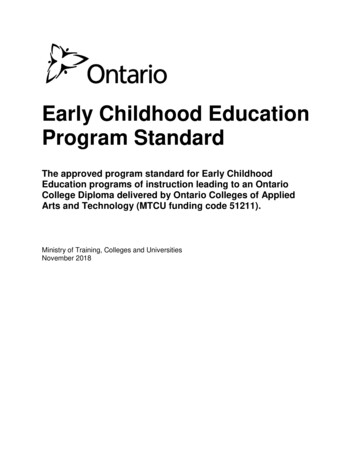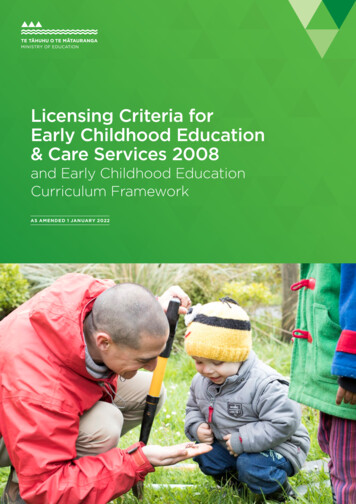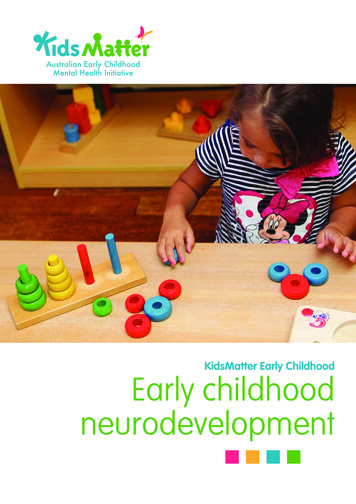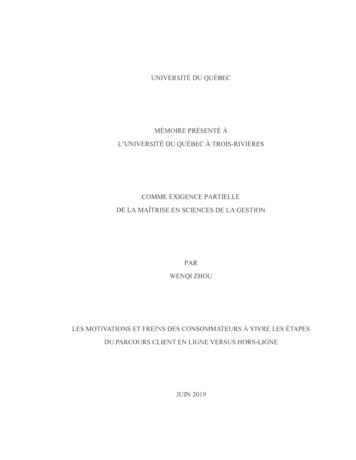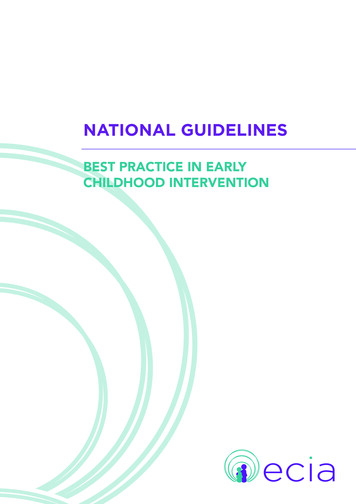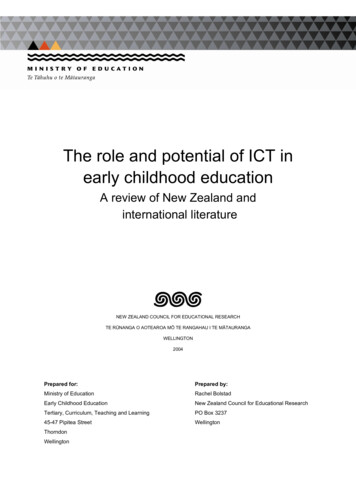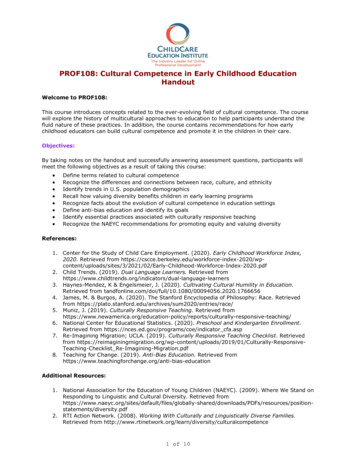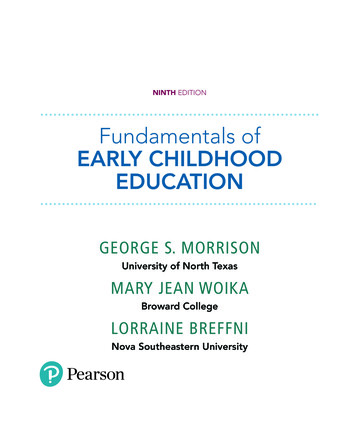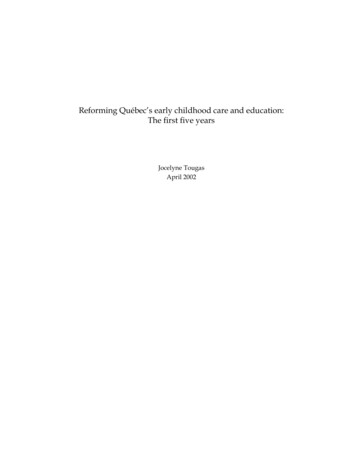
Transcription
Reforming Québec’s early childhood care and education:The first five yearsJocelyne TougasApril 2002
Reforming Québec’s early childhood care and education: The first five yearsJocelyne TougasChildcare Resource & Research UnitCentre for Urban & Community StudiesOccasional Paper 17March 2002 viii, 86 pp.ISBN 1-896051-20-0Childcare Resource & Research UnitCentre for Urban & Community StudiesUniversity of Toronto455 Spadina Avenue, Room 305Toronto ON M5S 2G8, ver design: Opus HouseCanadian Cataloguing in Publication DataTougas, JocelyneReforming Québec’s early childhood care and education: The first five yearsIssued also in French under title: La restructuration des services éducatifs et de garde à l’enfanceau Québec.Includes bibliographical references.ISBN 1-896051-20-0I. Child care services — Québec (Province). 2. Early childhood education — Québec (Province). I.University of Toronto. Childcare Resource and Research Unit. II. TitleHQ778.7.C32Q8 2002362.71’097144C2002-901911-7
About the authorJocelyne Tougas works as a translator and a researcher, and is a consultant on Québec’schild care policy. Her field of expertise covers the effects of government child carepolicies on children and their parents, on the child care workforce, on women and onsociety as a whole.She has been involved in the field since the late 70’s, first as a parent searchingdesperately for quality child care, then as Executive Director of Québec’s Association ofFamily Day Care Agencies, from 1983 to 1993. From 1993 to 1996, she worked asExecutive Director of the Child Care Advocacy Association of Canada.Since 1996, as a consultant, she has been co-ordinating the Canadian Union of PostalWorker’s child care fund for Québec — helping to set up projects for the Québec andMontreal locals and supporting the Union in its actions to improve access to qualitychild care both in Québec and in Canada.In 1997, Ms. Tougas became one of the principal researchers on the You Bet I Care studyon wages, working conditions and practices in child care in Canada. Currently, she is amember of the Steering Committee of the Family Day Care Training project sponsoredby the Canadian Child Care Federation.AcknowledgementsIn writing this Occasional Paper for the Childcare Resource and Research Unit, I wasfortunate enough to talk to a great number of people, associates, colleagues and friends.They willingly shared with me their thoughts and insight on early childhood educationand care in Québec and on the recent and ongoing changes in the field. I wish to thank :Nathalie Bigras, ECCE teacher, Cégep de St-HyacintheOdette Bouchard, Co-ordinator, school-age child care program, Lac-EtcheminSylvie Charbonneau, Cabinet, Ministre de la Famille et de l’EnfanceNathalie D’Amours, President, Association des éducatrices en milieu familial duQuébecDaniel Fines, Ministère de la Famille et de l’EnfanceChantal Fortin, Director, CPE À la bonne garde, Lac-EtcheminJohanne Gauthier, Ministère de la Famille et de l’EnfanceBrigitte Guy, President, Association des services de garde en milieu scolaire du Québec5
Andrée Langlois, Family Child Care Provider, Lac-EtcheminMicheline Lalonde-Gratton, ECCE professor, Université du Québec à MontréalFrancine Lessard, Executive Director, Fédération des centres de la petite enfance duQuébecCéline Michaud, Ministère de l’Éducation du QuébecCarole Perreault, Director, CPE Calou, Saint-Joseph-de-BeauceClaudette Pitre-Robin, Director, Regroupement des CPE de la MontérégieYves Rochon, Confédération des syndicats nationauxSylvie Tonnelier, Fédération des intervenantes en petite enfance, CSQFrançoise Tremblay, Ministère de la Famille et de l’EnfanceJocelyne TougasThe support of Child Care Visions, Human Resources Development Canada for itscontribution to the Childcare Resource and Research Unit that make its OccasionalPaper series possible is very much appreciated. The point of view in this paper does notnecessarily represent that of Human Resources Development Canada.Thanks as well to Judith Bell for fine editing and Maureen Emanuel for manuscriptpreparation.Martha FriendlyCo-ordinatorChildcare Resource and Research UnitUniversity of Toronto6
ContentsChapter 1Child care services at the heart of Québec’s family policyChapter 2The early childhood agencies or CPE’s (centre based component)Chapter 3The early childhood agencies or CPE’s (family child care component)35Chapter 4School-age child care programs51Chapter erences117817
1Child care services at the heart of Québec’s family policyINTRODUCTIONIn January 1997, the government of Québec announced three key family policy measureswhich would, in the words of then Premier Lucien Bouchardsupport some of the Government’s major objectives, including the fight againstpoverty, equal opportunity, the development of the social market economy,transition from welfare to the workforce and increased supports to working parents.In addition to being at the centre of the Government’s strategy, these new measuresreinforce the most important values of our society: sense of family and love ofchildren.1The three measures in question were first, an integrated child benefit for low-incomefamilies, second, good quality early childhood education and child care services, and third,an improved parental insurance plan. Pauline Marois, then Minister of Education withresponsibility for child and family policy, added:in Québec, as elsewhere in the world, society revolves around the family. It is whereour children learn the values that help them grow and open to the world. Despitethe fact that a majority of families consist of two parents and their children, thepicture is progressively changing. We find more and more lone parent families andblended families, and more women are active in the labour force. The Governmentneeded to adapt its policies to the changing needs of families. This is why our newfamily policy measures aim at insuring all children in Québec benefit fromconditions that promote, through early childhood intervention and care, theirdevelopment and success in school.2Government of Québec (1997). Translated excerpt from Communiqué 23 janvier 1997. On line:http://www.famille-enfance.gouv.qc.ca/5 communique/19 communique.html.2 Ibid.1
These statements are revealing, illustrating as they do the Québec government’srecognition of the multiple dimensions of early childhood care and education (ECCE) andthe important place accorded to it in government policy. The Premier asserted that ECCE iscentral to the government’s social development strategy, while Minister Marois consideredECCE to be vital to child development. Québec invests public funds in ECCE because, inaddition to supporting employment and allowing parents to play an active role in theworkforce, ECCE also supports parents in their parenting role; furthermore, it provides bothan opportunity for the transmission of values and a stimulating environment in whichchildren can learn, develop and grow. Québec’s Act Respecting Childcare Centres andChildcare Services, which came into effect in 1997, stipulates that:every child is entitled to receive good, continuous, personal childcare until the endof primary school.3This vision of child care is close to that of the Scandinavian countries; in Denmark, forinstance, parents have since 1993 been assured spaces in state-subsidized child care forchildren aged from 1 to 6. Child care in Denmark is regarded as a matter of children’s rightsand is based on the Danish philosophy that the State has a responsibility for the well-being ofits citizens.4Before the 1997 reformThe mandate assigned to early childhood care and education in Québec, and the multipleroles attributed to it led the government to re-examine the education programs offered tochildren between the ages of 0 and 12, and to introduce major changes. Before moving to adiscussion of these changes, however, we should look at the situation of Québec’s child caresystem before 1997, a relatively well developed system.Before 1997, the child care system for children aged from 0 to 5 consisted of some 78,000regulated spaces; roughly 60,000 of these were in centre-based and 18,000 in family childcare. The system received approximately 240 million annually in government funding forequipment, operating costs and fee subsidies (for low-income families). Responsibility forchild care lay with the Office des services de garde à l’enfance, a government agencymandated to determine child care needs, develop child care services consistent withQuébec’s other family policies, and regulate and ensure child care quality.Government of Québec (1997). An act respecting childcare centres and childcare services. Éditeur officiel du Québec.Paragraph 2.4 Beach, J., Bertrand, J. and Cleveland, G. (1998). Our childcare workforce: From recognition to remuneration: More thana labour of love. Ottawa: Child Care Human Resource Study Steering Committee, c/o Canadian Child CareFederation, p. 20.32
At the time of the 1997 reform, responsibility for the Office lay with the Ministry ofEducation (Ministère de l’Education or MEQ); at the time of the Office’s creation in 1979,however, the Department of Health and Social Affairs had had the responsibility, and at yetanother point, it was Québec’s Status of Women Department that was responsible. Despitethese changes in departmental responsibility, however, the child care portfolio had for sometime been consistently the responsibility of the same Minister, both before and after thereform. This continuity, together with the determination, persistence and convictions of thatMinister, may well have played a key role in determining the Québec government’sapproach and its decisions on child care. A thorough understanding of child care and itsmany ramifications is required to recognize its full social and economic significance, to see itas more than a purely private issue of primarily parental concern, and to make the politicaldecision to invest massively in a child care system.Minister Pauline Marois stated:what is proposed by the new family policy measures is a gigantic effort in childcare, a necessary step for the future of our society.5For children of school age (ages 6 to 12), the system of child care programs delivered in1998 approximately 92,500 spaces divided among some 800 programs in Québec’selementary schools,6 and received an estimated 41 million in government funding. Schoolage programs were, and still are, the responsibility of the MEQ.However, the 78,000 spaces in regulated centre-based and family child care, and the92,500 in school age child care were insufficient to meet the demand or fulfill childdevelopment or family support objectives. A survey conducted in 1998 by Québec’s statisticsbureau (BSQ) revealed that 70% of families with children under the age of five and 62% offamilies with children ages 6 to 12 used child care, with 49% of them doing so on a regularbasis so that parents could work or study.7 This makes for a large number, as there areapproximately 1.1 million children under the age of 12 in Québec. Because of a shortage ofspace, the majority of those children — 52.6%8 — did not have access to regulated child careof known and monitored quality. Further, given the eligibility criteria for the child care feesubsidy (financial exemption) program, a program targeting primarily low-income families— i.e. those with an annual income of between 12,000 and 40,300 (for a two-parent familyGovernment of Québec (1997). Communiqué 23 janvier 1997. On line: http://www.familleenfance.gouv.qc.ca/5 communique/19 communique.html.6 Childcare Resource and Research Unit (2000). Early Childhood Care and Education in Canada – Provinces andTerritories 1998. On line: http://www.child carecanada.org.7 Bureau de la statistique du Québec (1999). Enquête sur les besoins des familles en matière de services de garde. Éditeurofficiel du Québec, pp. 25–26.8 Ibid., Table 3.1.2.53
with two children) — a large proportion of middle-income families did not have the meansto pay the fees required for regulated care.9 This meant that, even if access to a space inregulated care had been available, these families would have been obliged to have their childcared for outside the subsidized, regulated system, or to let the child go home alone afterschool.Québec families thus found the regulated child care system inaccessible andunaffordable. With a surge of research studies attesting to the importance for young childrenand their future of care in a healthy and safe environment that is stimulating and enriching,the government made the decision to reorganize the child care system and to integrate it intothe early childhood care and education component of Québec’s new family policy.Early Childhood Care and Education: After the ReformQuébec’s educational services for children now have three major components — earlychildhood agencies (centres de la petite enfance [CPEs]), school-age child care programs andfull-day kindergarten. In order to support the child care reform and ensure itsimplementation, the Government of Québec began first by creating in May 1997 a newMinistry, the Ministère de la Famille et de l’Enfance. It’s mission “to foster with theassistance of family partners the overall development of children and families”. It took overthe responsibilities that belonged to the Office des services de garde à l’enfance and theSecrétariat à la famille.The first component, under the aegis of the Ministère de la Famille et de l’Enfance(MFE) is centre-based child care (group child care) for children ages 0 to 4; and family childcare for children ages 0 to 12. These two types of setting are overseen by single organizations,known as centres de la petite enfance (CPE) or early childhood agencies. Eventually, other,more flexible modes of child care will be added to these in order to meet a wider variety ofneeds (such as the need for child care outside of normal working hours). The CPEs werecreated out of the non-profit child care centres and family child care agencies that formed thecornerstone of the system until 1997. All CPEs are non-profit and run by boards of directorson which the majority of members are parent users.Median monthly parent fee for full-time care in child care centres: 477 (0 to 17 months), 455 (18 months to 3years), 440 (3 to 5 years, 11 months). Doherty, G., Lero, D., Goelman, H., LaGrange, A., Tougas, J. (2000). You BetI Care! A Canada-wide study on: Wages, working conditions, and practices in child care centres. Centre for Families,Work and Well-Being, University of Guelph, Ontario, Table 10.6. Median daily fees charged in family child care: 21 (infants) and 20 (18 months to 5 years, 11 months), in Doherty, G., Lero, D., Goelman, H., Tougas, J.,LaGrange, A. (2000). Caring and learning environments: Quality in regulated family child care across Canada. Centre forFamilies, Work and Well-Being, University of Guelph, Ontario, Table 5.5.94
As of March 31, 2000, Québec boasted 865 CPEs. Table 1.1 illustrates the growth in thenumber of spaces available in CPEs since the start of the reform. It should be noted that as ofDecember 31, 2000, there were 114,553 spaces in regulated child care in Québec. This includesthe spaces available in for-profit (commercial) child care centres and centres with boardswithout a parent-user majority (i.e. those run by school boards and municipalities that arenot part of the CPEs.TABLE 1.1: GROWTH IN NUMBER OF CPE SPACES AND TOTAL NUMBER OF SPACES AVAILABLE INREGULATED CHILD CARE, BY COMPONENT,YearNumberof 2002*** 915Spaces 97/98 TO 2000/2001Spaces in Total numberfamily childof spacescarein 17103,988114,017Spaces Total numberin otherof spaceschild care* 8114,553129,5591,396* Spaces available in commercial child care centres and centres with boards without a parent-user majority thatare not part of CPEs.** Figures as of December 31, 2000.***The most recent figures available (September 30, 2001).Community dimension and support for parentsThe government decided that Québec’s child care system should consist essentially of notfor-profit, community-based organizations (as opposed to private for-profit ones), to beadministered by parents, thus giving parents a prominent role in service delivery andeducational choice. It should be noted that, although Québec’s child care system is oftenconsidered to be a public system, it is not state-run in the same way as are, for example, theschools. Each CPE is independent, with its own charter and regulations. Although thesemust respect the parameters of Québec’s act Respecting Child Care Centres and Child CareServices, they give each CPE a certain uniqueness and distinct character.The government hopes that CPEs will gradually become “forums for exchange and mutualsupport between parents,” that they will deliver services to parents and work with otherpartners in the community (health and social services, municipalities, education, communityand family groups, etc.) to make programs accessible to the greatest number. This is aconcrete means of confirming that the primary responsibility for children’s education lies5
with the parents and that the parents must be directly involved and a driving force in theadministrative and educational decisions that concern them.Socio-educational dimensionThe very nature of CPEs, indeed their raison d’être, is socio-educational. They care forseveral hundred thousand children from all segments of society, from the first months oftheir life until they start school. The aim of Québec’s 1997 Act is “to enhance the quality ofeducational childcare provided by childcare centres, day care centres, nursery schools and homechildcare providers, and of childcare provided by stop-over centres so as to ensure the health and safetyand foster the development and well-being of the children to whom childcare is provided.”10Consequently, CPEs have the obligation and responsibility to ensure the basic care that isnecessary to protect children’s health and safety, and to provide them with a stimulatingenvironment in which they may develop to their full potential.School-age child care programsA second aspect of early childhood education, not formally presented as part of Québec’sfamily policy but nonetheless closely associated with it, is Québec’s system of before- andafter-school child care programs. It is currently estimated that there are no fewer than 1,249school-age child care programs in Québec’s various elementary schools, serving at least150,000 children between the ages of 5 and 12 in the elementary system. The fact that schoolage care is not immediately linked with Québec’s family policy and the system of CPEs andother child care services is without doubt because it falls within the jurisdiction of the MEQ,and not the MFE as do the others. Its funding is assured by the MEQ through the schoolboards. Like the other forms of regulated child care in Québec, since the implementation ofQuébec’s ECCE reform this sector has undergone spectacular growth.TABLE 1.2: OVERVIEW OF THE GROWTH OF SCHOOL-AGE CHILD CARE PROGRAMS AND USERSYearSchool-age child care programs1978/79 a37b1988/895741996/978411997/98 c9221998/99 d1,0901999/20001,2352000/2001 *1,249a CreationNumber of children of school-age child care programs.Government of Québec (1997). An Act respecting childcare centres and childcare services. Éditeur officiel du Québec,Paragraph 1.1.106
b Policystatement recommending acceleration of expansion and development of the system.Full-day kindergarten and homework assistance program.d 5/day program.* On November 23, 2000.Source: Association des services de garde en milieu scolaire du Québec.(See also Chapter 4, which deals more specifically with school-age child care and provides an overview of thecurrent situation and issues.)cThe effect of full-day kindergartenThe third component of the government’s ECCE strategy is full-day kindergarten for 5-yearolds, another MEQ program. The decision to introduce this was based on research showing adirect relationship between the length of time spent in kindergarten and the reduction ofboth elementary school grade-repeating rates and high-school dropout rates, andunderlining the positive role of kindergarten in subsequent schooling, social integration andpersonality development. The government decided to follow the many recommendations ithad received in this regard and to offer full-day kindergarten to all 5-year-olds and, as ofSeptember 1997, half-day kindergarten combined with free early childhood education andcare for 4-year-olds from disadvantaged areas. This last measure was introduced gradually,first in metropolitan Montréal, then in Québec City, and finally in other high-poverty areas.Although attendance is optional, more than 98% of Québec’s 5-year olds are enrolled infull-day kindergarten. The program has also received strong support within the educationsystem. With the introduction of full-day kindergarten came the implementation of arevitalized educational program adapted to the longer hours involved, and designed toprepare pre-school children for elementary school while avoiding the pitfall of too-earlyschooling.A way was needed to facilitate the transition among the various ECCE services (CPEs,kindergarten, school-age child care), avoid duplication and ensure cohesion among thevarious programs provided by the different services; the government’s response was to setup a “harmonization and integration” committee composed of all the various stakeholders.Funding the early childhood care and education systemThe restructuring of the ECCE system became reality with the gradual introduction of auniversal regulated 5-a-day child care program, an in-depth overhaul of the terms of childcare funding, and a massive increase in public funding.The effect of 5-a-day child care7
The MFE uses the term “reduced rate spaces” to designate spaces available for 5 a day incentre-based and family child care provided by CPEs, in subsidized child care centres thatare not part of CPEs,11 and in school-age child care. The system was introduced in stages.Initially, in September 1997, 5-a-day spaces were made available to 4-year-olds. In 1998,they became available for 3-year-olds and for children attending school-age programs. Thegovernment had set 2001 as the deadline for making the program accessible to all age groups,but was obliged to reconsider as a result of the program’s popularity and pressure fromparents. In the Fall of 2000, access to 5-a-day spaces was expanded to include infants so thatall children aged 0 to 12 attending CPEs, school-age programs and subsidized centres couldbenefit.It is important to note that the program is not simply an employment support measure;access to regulated child care — and hence to 5 spaces — is not restricted to parents in theworkforce or enrolled in school. All families are eligible. Furthermore, children from lowincome families may attend child care free of charge for 23 hours a week. The Ministry thusrecognizes the role played by early childhood care and education in prevention and earlyintervention. “implementing this type of early intervention program will promote equality ofopportunity among children, prevent learning disabilities and foster the development of required skillsto enter school.”12 For children attending school-age programs to be eligible for the 5-a-daysubsidy, they must attend child care on a regular basis for a minimum of 2 hours a dayoutside school hours.For low-income families with children attending regulated, unsubsidized child carecentres, (for-profit or are not part of the 5-a-day program for other reasons) the governmenthas continued its program of financial aid and exemptions based on family income.FundingFunding for the three types of child care settings (centre-based, family-based and schoolbased) is based on criteria that are, as one might suspect, highly complex. Criteria in each ofthe three settings are tied to current regulations (building requirements, ratios, group sizes,personnel certification and pay scales). A detailed examination of these funding mechanismsis not really relevant to this discussion, except to specify that the government funds capitalcosts in non-profit child care centres, covering more than 80% of their operating costs,“Subsidized” child care centres are either commercial centres or centres with a board of directors on whichparent users do not form the majority, and that have signed an agreement with the Ministry to make spacesavailable at the reduced rate.12 Government of Québec (1997). Translated from Communiqué 15 mai 1997. On line: http://www.familleenfance.gouv.qc.ca/5 communique/21 communique.html.118
including rent, general expenses, and child care and educational expenses.13 Thus, fees paidby parents with children in regulated child care in Québec cover less than 20% of CPE orschool-age program operating budgets, a significant reversal from the situation in the past,when parent fees accounted for almost 50% of the revenues of child care centres.14 This wayof funding child care has provided programs with stable financing. Child care occupancyrates no longer depend on parents’ ability to pay the fees; all the spaces are full, demand isincreasing and waiting lists are growing.Despite a substantial increase in the global budget allocated to the ECCE system,however, because government funding is limited and remains focused on basic care anddevelopment, child care programs do not have the leeway to explore arrangements to meetthe atypical needs of a growing number of families: irregular work schedules, evening, nightand weekend shifts, part-time or casual employment, siblings, children with special needs,etc. Such arrangements are more labour intensive — and subsequently more expensive toprovide — primarily because the adult-child ratio frequently needs to be lower, given thespecific needs of the children, the mix of age groups or variations in attendance.Increase in public funds invested in the child care sectorTables 1.3 and 1.4 provide an overview of the Québec government’s spending in earlychildhood care and education since the reform was undertaken.TABLE 1.3: GROWTH IN FUNDING TO CPES AND REGULATED CHILD CARE,1997/8 289,860,0001997/1998 TO 2000/20011999/20002000/2001 * 615,656,000 843,600,0001998/9 494,059,000* Official projections.15TABLE 1.4: GROWTH IN FUNDING TO SCHOOL-AGE PROGRAMS AND KINDERGARTENS,1997/1998TO 1999/2000School-age programsKindergarten1997/8 * 41,999,000n/a1998/9 ** 53,550,403n/a1999/2000 ** 70,989,051n/a* Estimate.For details on funding terms and conditions, consult Règles budgétaires pour le financement des centres de la petiteenfance, published by the MFE, and Règles budgétaires pour les investissements, published by the MEQ.14 Doherty, G., Lero, D., Goelman, H., LaGrange, A., Tougas, J. (2000). You Bet I Care! A Canada-wide study on:Wages, working conditions, and practices in child care centres, Table 10.1.1315The most recent official projections available (September 30, 2001): 1,024,436,600.9
** Compiled from MEQ published reports.The reform of child care in Québec was undertaken at a time when, as in otherCanadian provinces, the government was doggedly and obsessively trying to reduce itsbudgetary deficit to zero by the year 2000. In order to fund the first year of the new system,the government abolished some child-related programs (family allowances, and allowancesfor newborn and young children) and transferred those budgets; as well, it repatriatedQuébec’s portion of the federal Child Benefit and recovered sums allotted for provincialchild care income tax deductions. Furthermore, the introduction of full-day kindergarten andthe enrolment of thousands of 5-year-olds in the public school system freed up existing childcare spaces. This made possible an increase in the percentage of children ages 0 to 4 in childcare without requiring more investment. In the second and subsequent years, given the levelof public support for the program as well as widespread pressure for greater development ofchild care, the government was able to justify the injection of new funds by pointing to shortterm savings in social assistance, early intervention programs and remedial services.Specific measuresEducational programCPEs (both centre-based and family care components) and child care centres are subject toregulations governing the physical layout of their premises, children’s health and safety,educational support and staff training (cf. MFE’s Regulation Respecting Child Care Centres).To assist child care programs in carrying out their mandate, the government adopted a coreeducational program concurrently with the global implementation of the child care reform,requiring that it be adopted by all regulated child care services. The aim of the educationalprogram is to ensure: well-rounded, harmonious development, i.e. full development of all aspects of thechild’s personality; socio-affective, moral, language, intellectual, physical and motor; quality education; educational continuity among families, CPEs and other educational services, tofacilitate the child’s transition to kindergarten and to foster scholastic success.1616 Ministère de la Famille et de l’Enfance (1997). Translation. Child care centre educational program. Éditeur officieldu Québec.10
Although it is based on the program Jouer, c’est magique, a Québec version of theAmerican High/Scope Educational Approach proposed as an intervention framework forchildren from disadva
Reforming Québec's early childhood care and education: The first five years Jocelyne Tougas April 2002 . 4 Reforming Québec's early childhood care and education: The first five years . however, the child care portfolio had for some time been consistently the responsibility of the same Minister, both before and after the reform. This .
